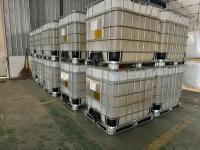Polyamine with 50% solid content and a viscosity of 1000 - 4000 cP has several important applications in mineral processing and water treatment, which are described below:
-
Flotation Agent: In the mineral flotation process, polyamine can be used as a collector or modifier. Its polar groups can adsorb onto the surface of minerals, changing the surface properties of the minerals. For example, in the flotation of some non - ferrous metal ores such as copper, lead, and zinc ores, polyamine can selectively adsorb onto the surface of valuable minerals, making them hydrophobic and easier to attach to air bubbles, thereby improving the flotation efficiency and recovery rate of valuable minerals. Moreover, for some fine - grained minerals, the high - viscosity polyamine can help form aggregates of mineral particles, which is beneficial for their flotation separation.
-
Slurry Thickening and Dewatering: In mineral processing plants, after the ore is crushed, ground, and separated, there is a large amount of slurry that needs to be treated. Polyamine can be added to the slurry to promote the aggregation of fine - grained solid particles in the slurry. The 50% solid content and appropriate viscosity of polyamine can ensure its good dispersion and reaction in the slurry. As a result, the solid - liquid separation effect is improved, the thickness of the slurry is increased, and the moisture content of the filter cake after dewatering is reduced. This not only facilitates the transportation and disposal of the tailings but also reduces the loss of water and valuable components in the tailings.
-
Dispersion and Conditioning Agent: In some cases, polyamine can also be used as a dispersion and conditioning agent for mineral slurries. It can prevent the aggregation of some minerals that are easy to agglomerate, keep the mineral particles evenly dispersed in the slurry, and improve the stability and fluidity of the slurry. This is particularly important in the grinding and classification processes of minerals, which can help improve the efficiency of these processes and the quality of the final product.
-
Coagulation and Flocculation: In water treatment, polyamine is an effective coagulant and flocculant. When added to water, the polyamine molecules can neutralize the negative charges on the surface of suspended particles, such as clay particles, organic matter, and bacteria. The 50% solid content and 1000 - 4000 cP viscosity ensure that the polyamine can be well - distributed in the water and have sufficient contact with the suspended particles. As a result, the particles aggregate and form larger flocs, which are easy to settle or be filtered out, thereby improving the clarity and quality of the water.
-
Wastewater Treatment: For industrial wastewater and domestic sewage, polyamine can also play an important role. It can effectively remove various pollutants in the wastewater, such as heavy metal ions, suspended solids, and organic matter. In the treatment of some wastewaters with high organic content, polyamine can not only promote the flocculation and precipitation of organic matter but also have a certain adsorption and degradation effect on some soluble organic substances. In addition, in the treatment of wastewater containing heavy metal ions, polyamine can form complexes with heavy metal ions, which are then removed by flocculation and precipitation, reducing the content of heavy metal ions in the wastewater to meet the discharge standards.
-
Sludge Dewatering: Similar to its application in mineral processing, polyamine is also widely used in the sludge dewatering process of water treatment plants. It can improve the dewaterability of sludge, reduce the moisture content of sludge cakes, and facilitate the subsequent treatment and disposal of sludge. By adding polyamine, the structure of the sludge is changed, and the bound water in the sludge is released, making it easier to separate the water from the sludge through mechanical methods such as filtration and centrifugation.

